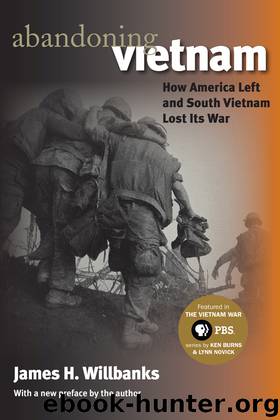Abandoning Vietnam by James H. Willbanks

Author:James H. Willbanks
Language: eng
Format: epub
Publisher: University Press of Kansas
Published: 2018-06-03T16:00:00+00:00
With the signing of the “Agreement on Ending the War and Restoring the Peace in Vietnam,” Nixon had brought the Vietnam War to an end, at least as far as the United States was concerned. However, as Stephen Ambrose points out, the convoluted negotiations and the bombing of North Vietnam had resulted in a peace settlement that was scarcely different from the one that had been proposed in October. Nevertheless, President Nixon later declared that, by 1973, when the Paris Peace Accords were signed, “We had won the war in Vietnam. We had attained the one goal for which we had fought the war. The South Vietnamese people would have the right to determine their own political future.”124 What they actually got was the right to fight the Communists on their own, because the peace settlement did not resolve the issue over which the war had been fought in the first place—as Le Duc Tho had stated earlier, “the problem of power in South Vietnam.”125 Although the accords stopped the fighting for a very brief period of time, the agreement was doomed to failure because it mandated the departure of the remaining U.S. forces from Vietnam, but not that of the estimated 150,000 NVA troops encamped in the Central Highlands and elsewhere throughout South Vietnam who could be very easily reinforced after the Americans had left.126
The situation was made worse by the fact that the agreement provided no effective means to enforce the cease-fire. The Joint Military Commission and the International Commission of Control and Supervision, both of which were supposed to help enforce the cease-fire, worked on the principle of unanimity, giving North Vietnam a veto on the Joint Commission and the Communists the same blocking power on the International Commission.127 What ensued was what the Communists called “half war and half peace.”128 As Stanley Karnow predicted in a January 1973 article in The New Republic, the cease-fire proved to be only “an interlude” that preceded “the beginning of what could become the third Indochina war.” He added that it remained to be seen “whether the struggle that lies ahead can be waged without American involvement.”129 For the United States, the war was over. For the South Vietnamese, the war was just beginning another phase. The efficacy of Nixon’s Vietnamization policy and the force that it built would be put to the final test without U.S. support of any kind—South Vietnam would have to face the Communists completely on its own. In early February, Kissinger told journalist Marvin Kalb that “it had always been our intention to enable the South Vietnamese to take over the burden of their own military defense and we believe we have left them in a position where they can handle most of the challenges that we can now foresee.”130 This was a hopeful assessment; unfortunately, the Vietnamization program that Kissinger alluded to had not solved the many long-standing problems of the RVNAF. Additionally, the massive equipment provided by the United States as it departed
Download
This site does not store any files on its server. We only index and link to content provided by other sites. Please contact the content providers to delete copyright contents if any and email us, we'll remove relevant links or contents immediately.
| Africa | Americas |
| Arctic & Antarctica | Asia |
| Australia & Oceania | Europe |
| Middle East | Russia |
| United States | World |
| Ancient Civilizations | Military |
| Historical Study & Educational Resources |
1-Bound by Honor(782)
The Saigon Sisters by Patricia D. Norland(673)
A Piece of My Heart by Keith Walker(558)
What We Inherit by Jessica Pearce Rotondi(555)
Into Cambodia by Keith Nolan(544)
The United States, Southeast Asia, and Historical Memory by Pavlick Mark;(539)
Abandoning Vietnam by James H. Willbanks(538)
The March of Folly by Barbara W. Tuchman(537)
Where the Domino Fell by James S. Olson & Randy Roberts(537)
Gunship Pilot by Robert F. Hartley(532)
12, 20 & 5 by John Parrish(528)
We Were Soldiers Once...and Young by Harold G. Moore;Joseph L. Galloway(525)
They Were Soldiers by Joseph L. Galloway(518)
Charlie Company's Journey Home by Andrew Wiest(513)
A Time for War: The United States and Vietnam, 1941-1975 by Robert D. Schulzinger(499)
Rethinking Camelot: Jfk, the Vietnam War, and U.S. Political Culture by Noam Chomsky(491)
Green Beret in Vietnam by Gordon Rottman(491)
Carrier: A Guided Tour of an Aircraft Carrier by Tom Clancy(486)
America At War - Concise Histories Of U.S. Military Conflicts From Lexington To Afghanistan by Terence T. Finn(455)
